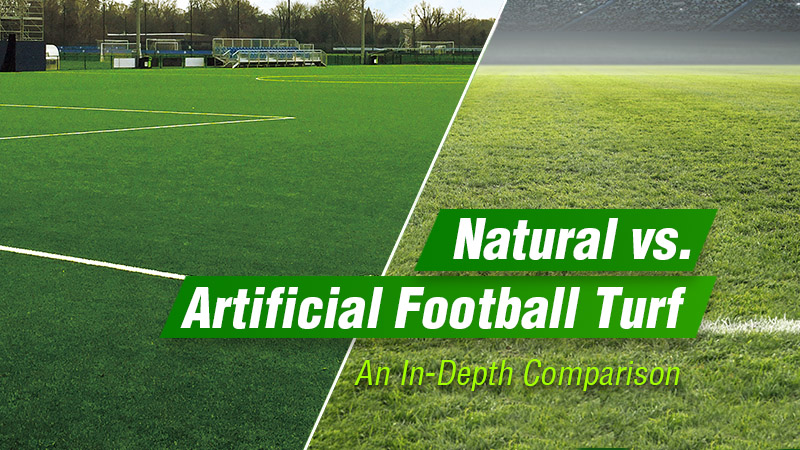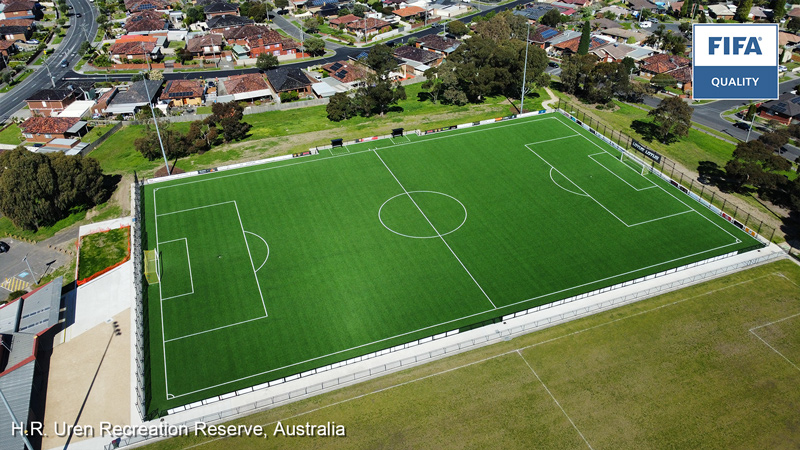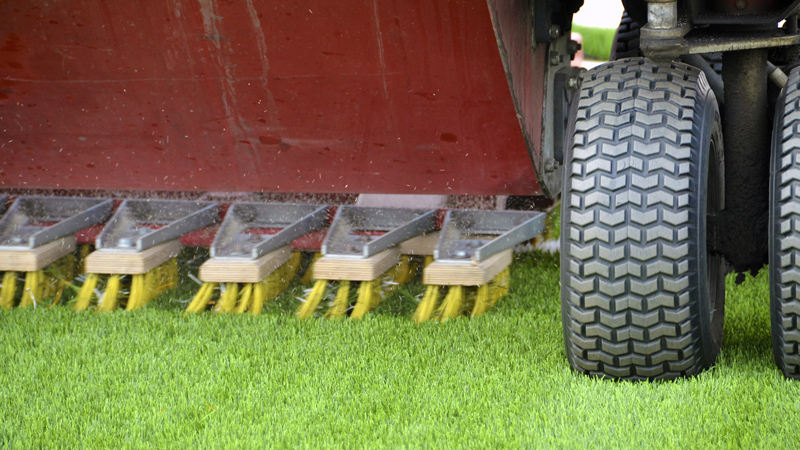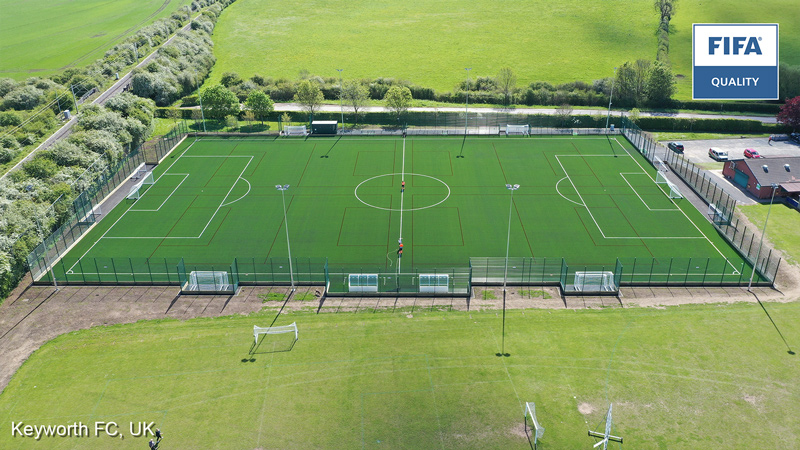Natural vs. Artificial Football Turf: Advantages and Disadvantages
- 06/26/2024
The debate between natural and artificial football turf is a long-standing one, influencing decisions in stadiums, clubs, schools, and recreational fields worldwide.
While both types of turf have passionate supporters and critics, this comprehensive guide offers a detailed comparison of natural grass versus artificial turf football fields. It focuses on critical aspects such as player health and safety, performance, maintenance, and cost to provide clarity for those navigating this important decision.

In this article:
- Player Health and Safety on Natural Grass vs. Artificial Grass
- Performance & Playability: Grass Fields vs. Synthetic Fields
- Maintenance Needs: Natural vs. Artificial Turf Football Pitches
- Installation and Long-Term Costs of Natural vs. Artificial Football Turf
- Aesthetic Appeal: Real Grass vs. Artificial Grass
- Summary of Natural and Artificial Football Turf
Player Health and Safety on Natural Grass vs. Artificial Grass
Safety is a crucial factor when choosing between natural grass and artificial turf. Below, we compare key safety aspects of each surface to provide a clearer understanding of their impact on player health and overall experience:
| Aspect | Natural Football Grass | Artificial Football Turf |
| Surface Consistency | Sometimes uneven due to weather and wear, potentially increasing the risk of falls | A stable and uniform surface reduces slips, trips, and falls |
| Traction | Generally good, but can vary with weather (wet grass can be slippery) | Good traction provided by infill material enhances player safety |
| Injury Risk | A softer surface reduces the impact on joints and muscles | Higher incidence of turf burns, abrasions |
| Heat Retention | Does not retain heat, making it cooler and more comfortable to play on | Can become very hot in direct sunlight. GrassCool system available for hot regions |
| Allergies | Produces pollen, which may trigger allergies in some individuals | Suitable for individuals with allergies or respiratory sensitivities |
Performance & Playability: Grass Fields vs. Synthetic Fields
Natural Grass Football Fields
- Many players favour the natural feel of grass, finding it more comfortable and enjoyable, which enhances their overall playing experience.
- Natural grass is highly susceptible to weather conditions. Heavy rain can create muddy, unplayable surfaces, while drought can damage the grass, leading to poor playing conditions.
- Natural grass fields offer a dynamic playing surface that some football enthusiasts value for its unpredictability and challenge.
Artificial Turf Football Fields
- Synthetic football pitches offer a reliable and consistent playing surface, promoting the quality of the game by ensuring fair and consistent ball bounce and ball roll.
- Artificial turf can handle extended playing hours, unaffected by daylight or seasonal changes. It withstands heavy use and diverse weather conditions, benefiting clubs and venues with high demand for field access or in regions prone to inclement weather.
- As a FIFA Preferred Provider, CCGrass football turf products meet all requirements of the FIFA Quality Programme. This means that our artificial grass football systems excel in all FIFA tests, such as ball roll, vertical ball rebound, shock absorption and skin friction.

Maintenance Needs: Natural vs. Artificial Turf Football Pitches
Natural Football Pitches
Traditional grass pitches require year-round upkeep to maintain optimal playing conditions.
Here’s a breakdown of their maintenance requirements:
- Mowing: Regular mowing to keep the grass at an optimal height for play.
- Irrigation: Adequate watering to ensure the grass remains healthy and resilient.
- Fertilization: Application of fertilizers to maintain nutrient levels in the soil.
- Pest and weed control: Management of pests and weeds that can affect the quality of the pitch.
- Aeration and overseeding: Essential for soil health and grass regeneration, requiring specialized equipment and labor.
- Pitch markings: Regular re-marking of pitch boundaries and lines.
Artificial Football Pitches
Artificial turf requires less day-to-day maintenance than real grass. The cost of maintenance is a lot less than on natural turf, but just as important.
Here are some key rules:
- Keep it clean: removing leaves, litter and other debris helps reduce contamination that may affect the pitch drainage.
- Keep the infill regulated: this means ensuring the rubber crumb is kept constant from edge to edge, especially in high-use areas, such as goal lines.
- Keep the fiber upright: helps ball-to-surface and foot-to-surface interaction.
- Keep it safe: check the pitch for loose seams, dips or bumps.

Installation and Long-Term Costs of Natural vs. Artificial Football Turf
How much does it cost for natural grass for a football field?
Traditional turf typically incurs variable initial material costs depending on the chosen grass seed or sod quality, alongside considerable expenses for ground preparation and installation labor. Additional costs may arise from installing irrigation systems, which vary depending on the size and complexity of the system.
It requires ongoing maintenance costs including watering, fertilizing, mowing, weed control, aeration, overseeding, and related labor and equipment expenses. These costs vary depending on factors such as field size, climate conditions, and usage intensity. However, if properly cared for, it can last indefinitely.
How much does it cost for artificial turf on a football field?
The initial installation cost of artificial football turf is significantly higher than natural grass, involving expenses for synthetic turf rolls, infill materials, and essential base preparation. Additionally, substantial labor costs are required for the installation process.
Despite these higher initial expenses, the lower maintenance costs can make artificial turf more economical over the long term. Moreover, a synthetic football field capable of withstanding continuous use opens up the possibility of renting it out to other teams, sports clubs and community usage.
Synthetic football turf typically lasts 8-15 years, depending on usage and quality. Replacement costs include removing the old turf, preparing the existing base, and installing new turf and infill materials.
Aesthetic Appeal: Real Grass vs. Artificial Grass
Real Grass for Football
There is something undeniably appealing about a well-maintained natural grass field. The look, feel, and even the smell of real grass are unmatched. It provides a classic, visually pleasing aesthetic that is deeply ingrained in the tradition of football.
Artificial Grass for Football
Modern synthetic grass is designed to closely resemble natural grass in appearance. While it may lack the charm of real grass, it offers a consistently green and manicured look year-round, regardless of weather conditions.
Additionally, it can be customized with a variety of colors, intricate patterns, and integrated logos, allowing sports teams, stadiums, or organizations to prominently showcase their branding.

Summary of Natural and Artificial Football Turf
Both natural and fake football turfs have their advantages and disadvantages, and the choice between them often comes down to specific needs, budgets, and priorities of the stakeholders involved.
Whether you favor the authenticity of natural grass or the practicality of artificial turf, understanding the key differences can help you make an informed choice that best suits your footballing needs.
Expert Advice on Choosing Football Turf
Unless you have the expertise, resources, and ongoing investment to maintain high-quality natural turf, opting for FIFA-certified football turf is a wiser and more cost-effective choice. Advanced artificial turf grass offers excellent durability and all-weather usability, with safety and performance that can rival premium natural grass.
Ready to install a top-quality artificial football field? With CCGrass, our expert team will guide you to the ideal surface solution tailored to your project’s needs. Get in touch with us today at 86 25 6981 1666 or via email at [email protected] to discuss your football turf needs.



